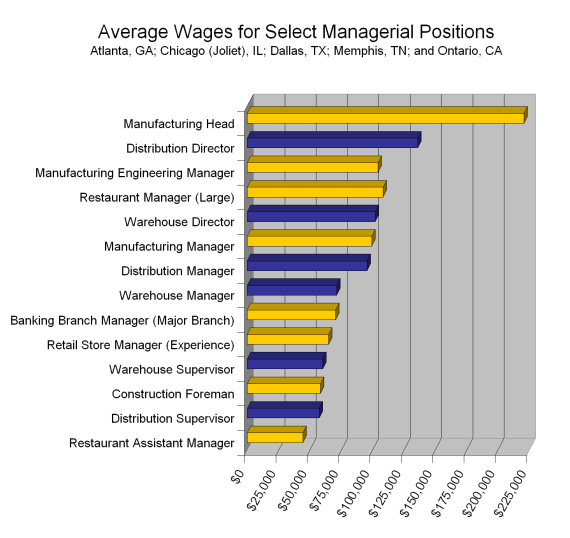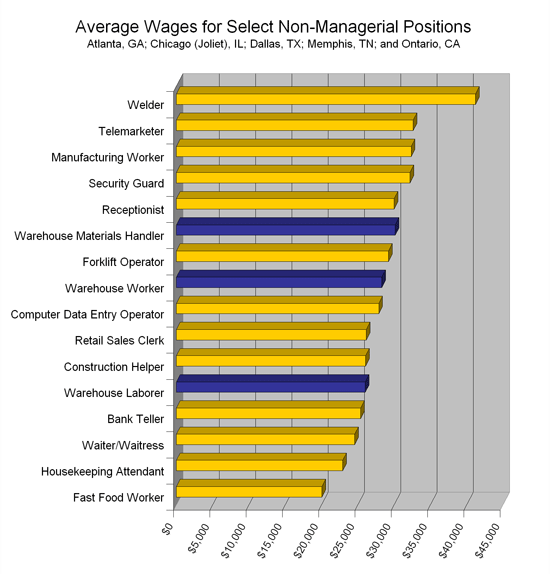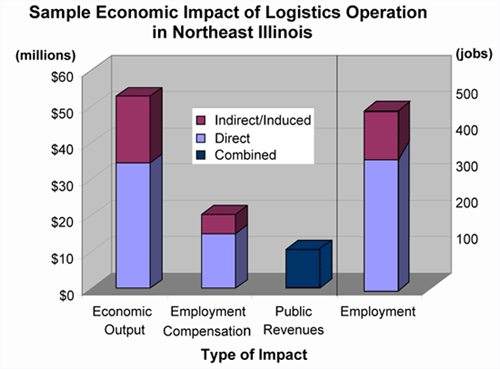t’sI a fact. Communities would rather have manufacturers and corporate headquarters than distribution centers. Economic development incentive packages rarely target DCs, residents frown at truck traffic, and community leaders fret about damage to roads.
The importance of the logistics industry is frequently lost on the general public.
“Why do we need all this import-export stuff? I can buy everything I need from the Wal-Mart down the street!”
Why does the port need to expand? Won’t we be getting everything on the Internet instead of in stores?”
Perhaps it’s easy for the public to take for granted that what they need will be where they need it, when they need it — and at a price they can afford. Maybe it’s difficult for some to understand efficient distribution channels are vital to economic success or that the continual efforts of logistics operations to shave time and cost from supply chains mean consumers are able to feed and clothe their families more easily.
Yet the general public’s lack of understanding is neither beneficial to communities nor to distribution operations. Communities are unknowingly passing over the benefits DCs bring to their local economies, including valuable jobs, property tax revenue, indirect and induced economic impacts, the potential to spur further growth, and philanthropic activity.
Meanwhile, DCs are failing to enjoy the benefits brought by good standing in the public eye, including faster, friendlier permitting; a reputation as a good corporate citizen and an employer of choice; potential incentives for new or expanding facilities; improved relations with neighboring residents and/or companies; and a more collaborative and effective community approach to addressing company needs.
Who’s going to correct the disconnect that exists between many DCs and their host communities? If distribution operations are to get full credit for all they contribute, company leaders must tell their story. They must be able to quantify their operation’s benefits to the community, and they must seek out opportunities to share the information. The following discussion will assist DC operators in developing their facility’s message to the local community.
One of the biggest hurdles is the misconception that all DC jobs are low-paying and low-skilled. Yet research on prevailing wages proves the distribution industry offers a range of wages, with management positions paying particularly well relative to other professions. (See Exhibit A.)

Even the lowest-paying warehouse jobs pay more than most retail and food service positions. (See Exhibit B.) Most distribution companies offer health benefits and on-the-job training for their workers, with many even offering a full range of excellent benefits including 401(k), performance bonuses, tuition reimbursement, and matching funds for educational institution support.
Furthermore, the idea that distribution jobs are low-skilled is clearly outdated. The general public needs to know these aren’t your father’s distribution center jobs. For example, most forklift operators in today’s operations must not only be certified to drive the fork truck, but also trained to operate the radio frequency scanning devices. The value-added functions bring with them additional supervision and higher-paying production, lead and quality control positions.
In addition, other functions often accompany the DC. A case in point is Centrella. When the largest cooperative food distributor in the Chicago area identified the need for a new 850,000-sq.-ft. (79,106-sq.-m.) food storage warehouse, it also decided to co-locate its headquarters with the distribution operation.

Nevertheless, while distribution facilities can bring well-paying, skilled jobs to the community, we can’t overlook the fact that a segment of the DC’s work force will receive entry-level wages for lower-skilled positions. Are those jobs any less desirable? As John Husing of Economics & Politics, Inc. notes, logistics is an industry with few barriers to entry — much like manufacturing used to be. Many positions require only a high school education. Thus, the logistics industry offers employment opportunities to that segment of the population with the fewest options for earning a livable wage. It also offers workers a career path, with earnings improving based on experience. Furthermore, some DCs offer part-time and/or daily contract positions, giving area residents the opportunity to get good-paying, flexible second jobs.
All of these are important points to make to community leaders and the local media. DCs would be well-served to compare their operation’s wages to area averages and to understand how they compare to other employers. Local workforce development boards and economic development agencies, as well as published labor statistics from federal and state sources, are resources for conducting such research.
Positive Impact on School Budgets
Distribution centers are big, and pay a lot of property tax. DC operators know this simply from looking at their financial statements. However, many do not fully appreciate how their property tax bill differs from those of other taxpayers. DCs have a low density of employees relative to their large footprint, meaning they’re contributing to the tax base without driving additional school district expenditures. This is an important selling point with local leaders.
DCs wanting to highlight this aspect of their operation can determine where their operation ranks among local major taxpayers by contacting their local tax assessor’s office.
Beyond Their Immediate Operations
Economic impact analysis estimates how an industry affects the region in which it is located. One of the most popular economic impact modeling tools is IMPLAN. IMPLAN is an input-output model built on the premise that a region’s economy is a complex web comprising supply chain interactions between industries, institutions and households. A change introduced to one industry will be felt as reverberations across the supply chain. The IMPLAN model can report a net effect in terms of annualized changes in economic activity, jobs, employee compensation and public revenues.
The results of the impact depend upon several factors including the type of industry and the study area in which the change occurs. Industries vary in the amount and source of inputs. When more of the inputs are supplied locally, the economic impacts on the local economy will be greater. In addition, industries that pay higher wages will likely impact an economy more than those that pay less. However, this is not always the case. The size and location in which the impacts occur are also important determinants of a project’s economic impact. Input-output models base the level of impact on the current mix of industries within the specified study area. The more diverse an area’s economy, the more likely an industry is to find suppliers and consumers within that mix. Urban areas tend to have more diverse economies than rural areas. Accordingly, it is possible for one industry in an urbanized setting to have a greater economic impact than a similar industry in a rural location.
A company’s impact can be divided into three categories: direct, indirect and induced.
- Direct
-
- : employment, earnings and output at the facility itself
- Indirect
-
- : employment, earnings and output resulting from purchases made by the DC in the local economy. For example, purchases of forklifts and repair parts, racking and/or shelving, equipment repair services, office supplies, packaging materials for shipping and value-added services, janitorial, pest control, and fuel are classified as indirect impacts. Additionally, the impact of visitors to the facility (management, truck drivers, customers, etc.) would also primarily fall in this category and would capture hotel stays, car rentals, food and beverage purchases, etc.
- Induced
- : employment, earnings and output resulting from the DC’s employees spending their wages in the local economy to pay for housing, groceries, clothes, entertainment, cars, haircuts, landscaping, childcare, etc.
When combined, these three types of impacts are used to quantify the effect the operation has on the local economy.
At the end of this article, readers will find an illustrative case study. Such an analysis can be conducted for any DC and is valuable information for companies to have when speaking with media and community leaders. While companies will have figures such as payroll and revenue readily available at their fingertips, translating these direct impacts into indirect and induced impacts on local job growth and revenues is best left to one of the analysis models such as IMPLAN. A local or regional economic development organization may have the needed tools to assist companies in estimating their impact. If you are using a site selection consultant for a location search, the consultant can likely provide these calculations.
When using the results of such an analysis, DC operators should bear in mind that other types of facilities — particularly manufacturing or highly paid headquarters operations — may wield higher impacts for the same size investment and/or number of new jobs. This becomes important if the impact analysis is being used by economic developers for the purpose of negotiating an incentive package with the DC. Company leaders should be realistic about the DC’s economic impact relative to “that other company that got more money.”
Nevertheless, sometimes communities lose sight of the fact that, while a distribution facility may not make the same economic contribution as a manufacturer, the contribution is notable. Furthermore, DCs should be aggressive in making sure the facility’s impact is not understated. Economic developers may assume the facility’s employment consists of pickers/packers and not realize there are other jobs on site such as dispatchers, back-office functions, managers, and/or highly skilled equipment operators. They may also fail to take into account the operation’s visitor traffic and/or construction expenditures and jobs (if applicable). To ensure all impacts are captured, the DC operator needs to have a full understanding of what is being included in the analysis.
Spur Further Growth
DCs should be aware of their potential to spur further economic growth in an area. Large DCs and those associated with well-known companies can be used to build the community’s résumé. They lend validity to the community as a suitable location for business. This can be leveraged in marketing efforts to attract other companies and industries to the area. Likewise, visits by company executives and/or clients put the community on the radar screen of decision-makers and, consequently, may lead to future investment.
In some cases, a DC might provide a missing catalyst for needed development, such as road improvements or neighborhood revitalization.
To get maximum credit for contributing to future area growth, DC leaders need to be proactive. It’s not just a matter of making sure local hotels realize how many overnight stays are a result of the DC’s presence. It may also involve creating opportunities for economic developers to have face time with visiting executives.
Distribution centers play an important philanthropic role in our communities. For example, Walgreen’s distribution facility in Anderson, S.C., has gone to great lengths to design operating procedures to meet the needs of people with physical or cognitive disabilities. Walgreen’s is extremely proud to offer employment to this segment of the population, which accounts for 38 percent of its work force. The facility has been featured on NBC Nightly News and ABC World News Tonight.
Other DCs actively sponsor local events, support charities, accept interns and/or work with local educational institutions to improve the local work force.
Building public awareness of a DC’s philanthropic activities is a great way to enhance the industry’s image and stature in the community.
There are a number of ways to communicate the benefits of the DC, including the following:
- Becoming active with the local economic development organization yields a behind-the-scenes opportunity to discover and correct any misconceptions. It also demonstrates a company’s interest in the economic well-being of the community.
- Networking with other business leaders through chambers of commerce, business roundtables, rotary clubs and other community events provides many outlets for sharing the DC’s story.
- If opening or expanding the facility, using press releases, interviews and other public speaking opportunities to talk about the project’s benefits gets the community excited about the DC and gives them a reason to be proud to call it their own.
The bottom line is that it is possible — even the norm — for other viable operations to be welcomed and valued. Distribution centers that find this is not their experience should consider whether there are ways to improve the situation through greater communication and education. DCs represent an important function in our economy. Communities deserve to know that.
Third Party Logistics Provider in Northeast Illinois
The following information is representative of a moderately-sized distribution center in northeast Illinois. Due to extensive economic, transportation and other linkages, the impacts would likely extend beyond the borders of a single county. Accordingly, the case study examines the impact on a region consisting of Grundy, Kendall and Will Counties. Since third-party-logistics operations incorporate a number of economic activities, we have modeled the facility’s operations to include warehousing, transportation by truck, and wholesale trade.

A distribution center with these characteristics would have the following impacts on the three-county region:
Employment:
Assumption: The facility would employ 325 positions. Impact: Related economic activity would generate or support more than 135 additional positions (full-time equivalents).
Annual economic output:
Assumption: The facility would generate approximately $34.5 million in annual revenues. Impact: Related activities would result in an increase of $18.4 million in economic output annually.
Employment compensation:
Assumption: The distribution center would produce $15 million in annual employment compensation (including wages, salaries, bonuses, benefits, and employer paid retirement and Social Security) Impact: Related economic activity would support or generate $5.4 million in additional employment compensation each year.
Public revenues:
Impact: Given the aforementioned assumptions, the economic activity and employment associated with the facility would result in annual increases of approximately $8.7 million in public revenues at all levels, including $5.2 million at the federal level and $3.5 million at the state/local level.
In summary, this company employs 325 workers, has annual revenues of $34.5 million and a payroll of $15 million. The facility also supports — outside of its walls, just by doing what it does — 135 additional jobs in the community, $18.4 million in economic output, and $5.4 million in additional compensation.

Tracey Hyatt Bosman is a Director in the Strategic Consulting Group of Grubb & Ellis, a global commercial real estate company based in Santa Ana, Calif. The Strategic Consulting Group specializes in business location services, incentives negotiation, development feasibility analysis, portfolio optimization, organization and process design, and transaction due diligence. Its professionals are also members of Grubb & Ellis’ Global Logistics Practice, an elite international team of real estate professionals experienced in the needs of the logistics industry.
Robin Hanna is a Project Manager for the Rural Economic Technical Assistance Center (RETAC) at the Illinois Institute for Rural Affairs (IIRA). RETAC supports economic development across rural Illinois by encouraging sound decision-making among communities and businesses alike. The Center offers a range of products and services including economic and fiscal impact studies, business marketing and feasibility studies, community retail analysis, and business retention/expansion services. Created in 1989, and located at Western Illinois University’s Macomb campus, RETAC is a unit within the IIRA’s Data and Technical Assistance Center. The Center also supports outreach and programming activities of Mapping the Future of Your Community, Health MAPPING, Peace Corps Fellows, and other IIRA units. More information can be found at www.iira.org.